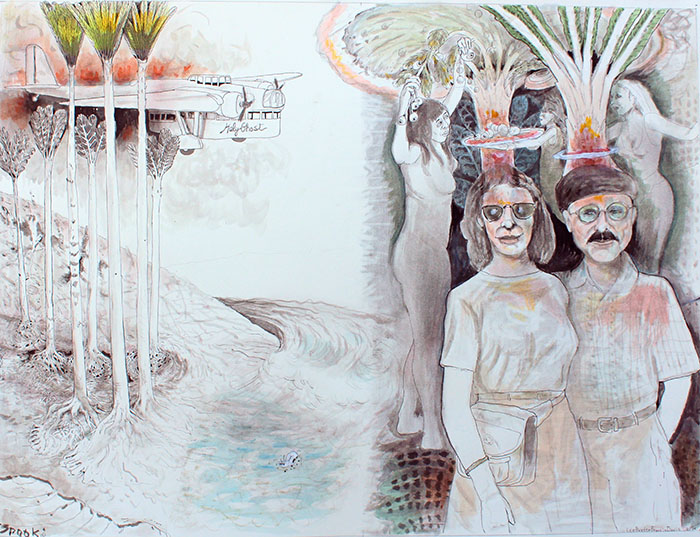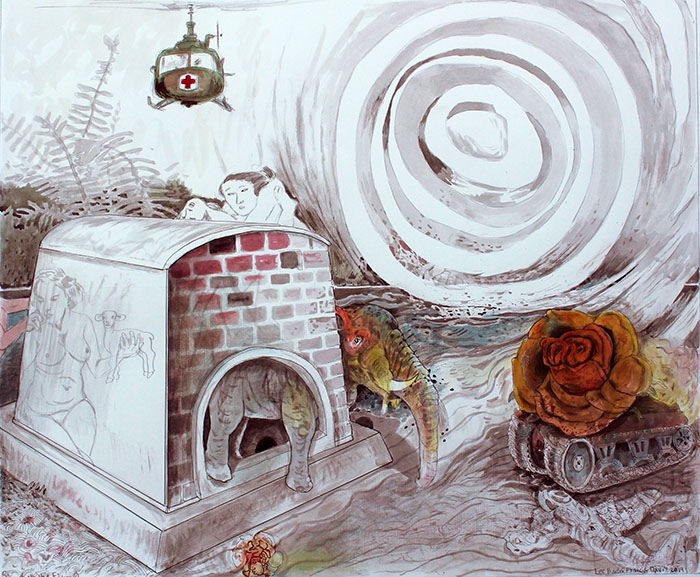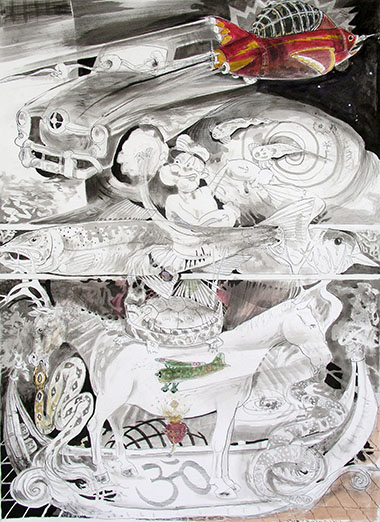Unmasking Symbols

I would like to address the nature of certain images that often appear in my art. Call them "cosmic ships" and "fabulous beasts." Decoding symbols is always a risky business since definitive labels can subvert the symbol's power. Of course, we are naturally cognitive and must name what we see. The power of symbol is its purity, like music without lyrics. That is to say, the image without a definitive context can take on a life of its own. What would it be like if all things were nameless? The power of nameless images is their mystery. The obvious solution of this duality is to put words and images together, hopefully forming an essence.
Let us begin this labyrinthine quest by considering the picture The Adventures of Ruby and Marcellus in Lizard Land (2007). Our heroes Ruby and Marcellus are confronting a contraption labeled with strange hieroglyphics. Marcellus, both confounded and intrigued, is ready to be swept away by its mystery. On the other hand, Ruby, the practical one, rejects this as nonsense. Up in the clouds, an enticing person is riding a bicycle on a highwire. In considering my images entitled "Cosmic Ships and Fabulous Beasts," you must do it riding on the highwire, where each of us must supply their own bicycle.
What better place to begin this ride than in the sky? In the sky can be seen certain lights or fires. These lights are the Big Bear, often called the Big Dipper of Ursa Major. You can, in this constellation, find the North Star, a fixed point in the sky. Some have seen the Big Bear as a coffin carried by pallbearers. They are carrying this coffin toward a fixed point. The coffin is a cosmic ship. See the illustration called Big Bear (2005).
In my art these various signs and symbols of cosmic ships and fabulous beasts are not always the main focus, but function as atmospheric props for the pictorial stage. The persona seen on this stage—images of human beings—serve as masks that the viewer may wear. In wearing the mask, the content of the pictorial space is activated. The real world of visible matter is replaced by imagery. All images are found in the real world of time and space, nature.
The imaginary world of pictorial space where cosmic ships and fabulous beasts can be found starts with a blank white sheet of paper that is a window into the world of dreams. This is a pictorial world of mythological invention where time can be made to stand still like a fixed point. Art, unlike life itself, can be toyed with as a game. Cosmic ships can be fabricated from the fires in the sky. They can take the shape of space ships or sweet chariots or beautiful flying things or sinister machines. The Christian monk Richard Rolle (1300-1349) saw the stars, the moon and the sun as metaphors for the love of God. The game of imagination can be both profound and superficial. How many angels can reside on the head of a pin? How many protons are in an atomic nucleus?
Fabulous beasts are animal things usually formed from composites of various beasts and people. An example of the fabulous beasts is the manticore. Sometimes fabulous beasts can double as cosmic ships. See illustration called Mistress of Wild Things (2018). All you have to do is give it wings or a watercraft bow. Both cosmic ships and fabulous beasts can transport the viewer to various levels of the mystic world.
In my drawing called Pop-eye and the Two-headed Horse (2013), the page is divided into an upper, middle and lower world. A Buck Rogers spacecraft is speeding out of the light into the upper world's dark sky. This craft, originally created by some artist in the 1930s, is supposed to be a rocket ship of the 21st century. This craft is a cosmic ship taking us to the mysterious starry night. The jet stream of this craft is a 1950s American car. This car that is acting as the Buck Rogers jet stream is designed to look like a space rocket. This is our second cosmic ship headed to the down-to-earth zone. The character Pop-eye, an alter ego, is smashing the car-ship in an attempt to alter its course. This segway attempts to express the duality of reason and mysticism.
The center panel is narrow and represents the reality of the earthly world. It is completely occupied by a fish, a fish out of water. In the underworld of water, a fish can be a cosmic ship, but this fish is too confined to swim or fly. Down in the lower world is a fabulous beast, a two-headed horse with antlers that seems to be holding up the stranded fish. This creature is fabulous indeed with its horns and two horse heads. The number three is considered the perfect number signifying the beginning, the middle and the end. The two horse heads are the unity of one plus one and the horse's body is the perfecting three. The end number suggests a conclusion or an end to time and space. Horse symbolism signifies "beast of burden," and the untethered mare represents the impending end of time, death. The horse head facing to the left is clasping a withering snake in its teeth. The head to the right is being bitten by the snake. Snakes are symbolic of earthly power. Could the two-headed fabulous beast be a form of Janus, the two-headed god looking to the past and the future? But this is not all; the horse is standing in an Egyptian papyrus boat, a cosmic ship that transports the dead to the underworld. At the underbelly of the two-headed horse being transported to the underworld we find the mysterious image of the Sacred Heart of Jesus. A vintage airplane is speeding toward the left in the direction of the subdued snake. Could this yet be another cosmic ship transporting us to the maelstrom of mysticism?

Using the information from the break-down of Pop-eye and the Two-headed Horse, look to the three drawings Natural Habitat (2016), Spook (2019) and Spirit of the Form (2019) and see where they might take you. Keep in mind that the overall theme of my artwork centers around the question of the "duality of being." In regard to this mystery of duality, consider the words of the great villain Captain Ahab. "Hark ye yet again, the little lower layer. All visible objects are but a pasteboard mask, but in each event the undoubted deed puts forth the moldings of its features from behind the reasoning mask." The artist with detachment and imagination invites the viewer to balance on the highwire and like Pop-eye, punch his way through the mask.



Lee Baxter Davis was born at Bryan, Texas. He enlisted in the regular army out of high school. Afterwards he attended college and graduated with a master’s degree from Cranbrook Academy of Art in Bloomfield Hills, Michigan. His best friend in both undergraduate and graduate school was James Surls. Lee taught fine art graphics at East Texas State University, now Texas A&M Commerce, for over thirty years. He was full professor and was chairman of printmaking, and later taught advanced drawing and figure drawing. Now retired, Davis is a deacon serving at St. William the Confessor Catholic Church, Greenville, Texas. He has been married to his college sweetheart over 50 years. They have two adult children and ten grandchildren. He works in his studio at home. His prints and drawings have been exhibited throughout the United States and are included in many permanent collections.


